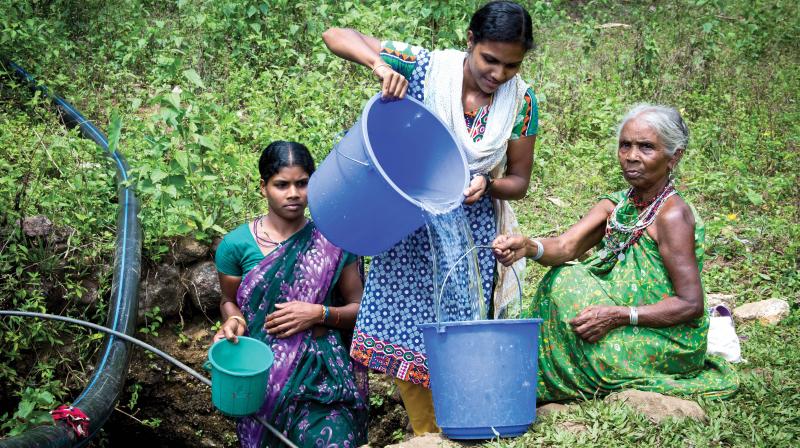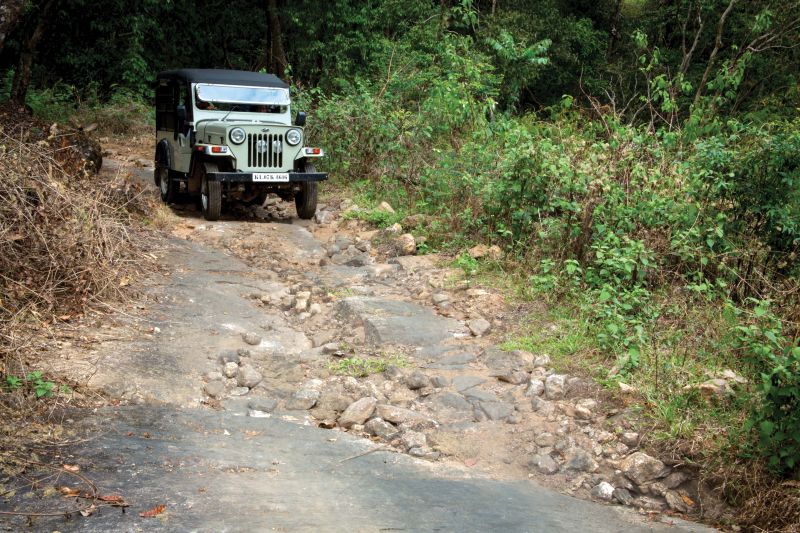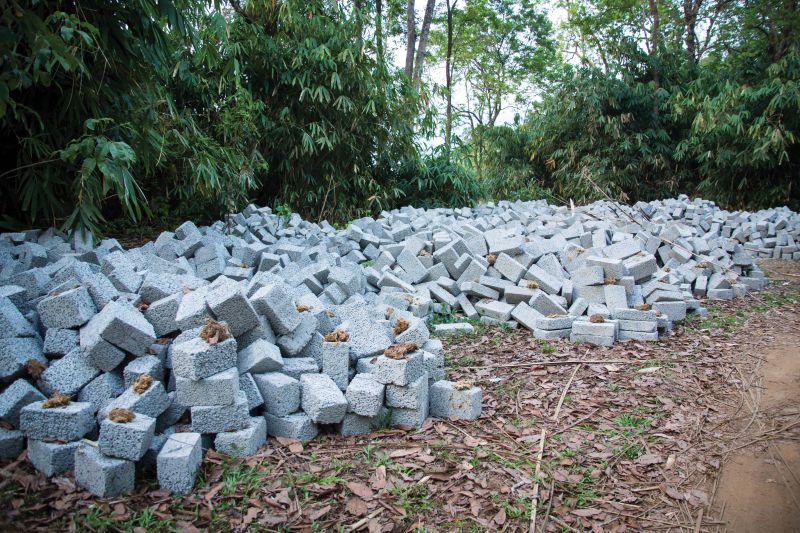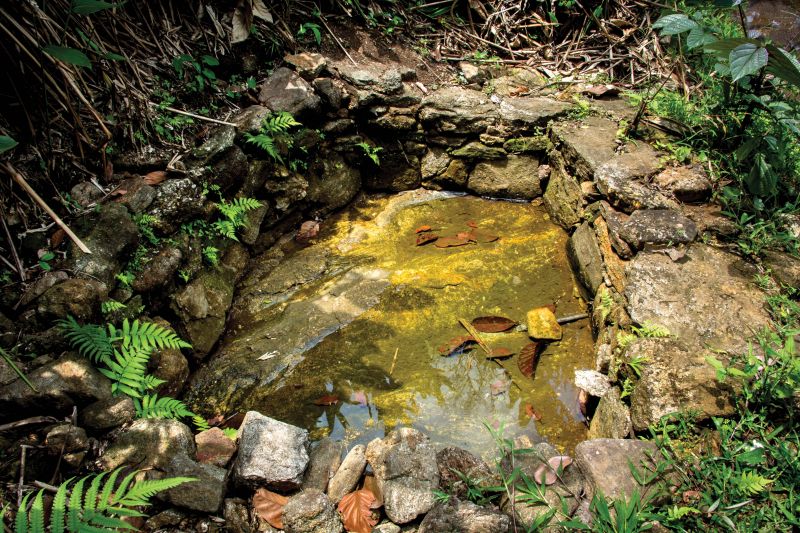Bringing a village close to town

Kochi: Deep within the jungles of Malayattor forest division live 76 Muthuvan families, cut off from the rest of the world and under the mercy of the gods. The government too has stepped in with various welfare measures, but any substantial improvement in their daily grind remains a dream. A visit to the Uriyampatty tribal colony, situated 30 km from Kuttampuzha town, Kothamangalam taluk, Ernakulam district, by this reporter was an eyeopener. From the nearest bus stop at Manikantanchal, it’s a 20-km off-road drive through forest. Sudha P.G., a section forest officer at Kuttampuzha range under the Malayattoor forest division, pointed to the heaps of concrete blocks on the sides of the spot where the forest trail begins. From there, only four-wheel drives are possible.
 Thatched huts in the tribal village.
Thatched huts in the tribal village.
“These are 30,000 cement bricks bought using the government grant for the housing project for the tribal people. Each household is entitled to a grant of Rs 3.50 lakh to build a 350-sq-ft home instead of their thatched huts. But Rs 3.50 lakh is not enough even to begin the construction. The entire amount would be spent by the time these bricks reach their settlement. The contractors have left the work midway due to lack of funds and facilities,” said Sudha, who led the toilet construction project of the Swachch Bharat Mission under which she helmed the construction of toilets in nine tribal colonies in Kuttampuzha.
No exaggeration here, because a trip to the colony from the town costs between Rs 3,500 and Rs 4,000 and one jeep can transport hardly 30 blocks. The funds won’t be sufficient to transport all the blocks to the settlements. The Muthuvan community, therefore, leads a reclusive life and they come down to the town either by foot or by jeeps paying for the expensive transport in case of emergency hospitalisation, schooling needs or to sell honey, arecanut or pepper collected from the forest.
 Road to Uriyampatti
Road to Uriyampatti
Thanks to the welfare measures of the government, the tribal families are in good health. They receive regular ration – foodgrain, pulses, sugar and basic essentials. The village has two solar power-enabled lamp posts which function from 6 p.m. till 6 in the morning regularly. But acute water scarcity, during summer, and poor road connectivity have been troubling the village for the past several years. Many tall promises made by leaders and officials who have visited the places remain on paper. Kumbakkaalu, 95, who lives at Uriyampatti with her children, grandchildren and great grandchildren, said: “The water we get here is collected in a pit and that’s not sufficient to quench the thirst of everyone, including wild animals – elephants, bisons and monkeys.”
 30,000 cement concrete blocks brought to construct houses lie unused by the wayside.
30,000 cement concrete blocks brought to construct houses lie unused by the wayside.
Gireesh, president of the Vana Samrakshana Samiti in the area, gives more details. “The streams where we get water are 1 to 3 km away. Water reaches the pit in the colony through small hoses connecting the stream. We save the water in the pit covered by nets. Mostly, women and children walk the whole three km of dense forest carrying water pots on their heads.” At Thumbimedu, a part of the colony where there are six huts, there’s a well and a huge tank built by Seva Bharati, which has also set up a generator to pump water. But since there’s not enough water, pumping is not possible and the tank remains dry. There are just two ‘proper’ water sources, which resemble puddles where water gets collected in between rocks.
“The only solution is to widen the current water source or to set up a water harvesting system for our household uses,” Gireesh opined. Water scarcity is not limited to Uriyampatti alone; there are colonies like Thera and Variyam which house 24 and 67 families, respectively. But Uriyampatti is the worst-hit. “That’s because ours is a poorly-connected place,” reasoned Kiliyamma, a sexagenarian at the colony, where little children were seen playing. There is an Ooru vidya kendram, the single-teacher school, which has no teacher.
 A dried up water tank.
A dried up water tank.
The colony has an anganwadi, the building of which has been lying in a dilapidated condition for the past 15 years. Bureaucrats pay a visit time and again, giving assurances, but nothing has been done so far. Now, the anganwadi where 26 kids learn runs in a makeshift thatched shed and a portion of the dilapidated, cracked building is used as a medical dispensary where a health officer visits regularly. For schooling, the kids are sent to tribal residential schools at Neryamangalam, Karukutty, Chalakkudy, Melukavu etc. But most of them drop out unable to cope with the schedule.
“We want our kids to study like everyone else. But connectivity poses a challenge. We have an anganwadi teacher, but she has been on leave for more than a month. How can we blame them for not coming here? Such is the plight of the road,” said Santhosh, who has been living at Uriyampatti for the past 15 years after his marriage to a woman from the colony. Regular health camps are organised in the colonies, but when it comes to immediate medical cases like child birth, road connectivity poses a challenge. “It takes nearly three hours for a jeep to come to the colony and take an injured person or a pregnant woman to the hospital and it is a very dangerous journey. Luckily, there haven’t been any casualties yet,” said Sudha.
Santhosh added: “We want a proper concrete road, not even a tarred one, just to improve connectivity. We are provided necessary facilities, but everything is left half done.” Like the 69 solar panels allotted from the Kuttampuzha panchayat to light up the colony. As no official has come to fix it up, the panels and construction material lie there in the dust. Currently, one solar panel caters to the power needs of six houses in the colony. “Everything would fall in place once we get a proper road. The water crisis during summer, our kids’ education and health facilities will improve when the road comes,” said Gireesh.
When contacted, Ernakulam district collector K. Mohammed Y. Safirullah said that building a tarred road to Uriyampatti had many challenges as the area falls under forest range and the matter came under the Forest Conservation Act. "Tarring is possible at a few places and we are following it up," he said. The collector had visited Uriyampatti last year and looked into the drinking water problem. "There is crisis, but it is not a drought-like situation. It's true that many areas are not connected by pipeline. The crisis is only during the summer season, mostly because water sources dry up.
“In this regard, last year, we had announced two projects amounting to roughly Rs 10 lakh and the processes are still underway. We also have plans to rejuvenate the water sources," he added. Since the water crisis might result in man-animal conflict as everyone depends on the same water source for their basic needs, the collector also said that the administration was considering setting up water projects in the tribal residential areas so that animals won't enter there looking for water.

